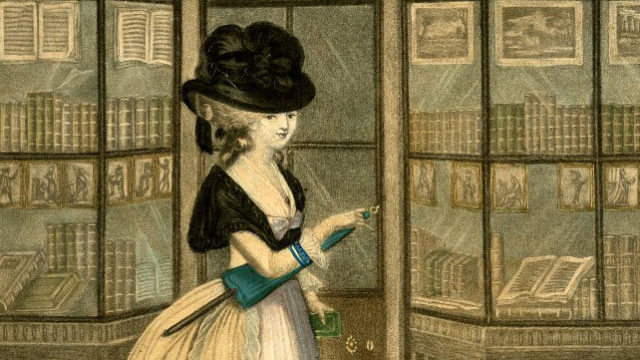http://womensprinthistoryproject.com. Accessed February 2, 2021.
The Women’s Print History Project is a database that collects in one place information about British women’s writing, editing, publishing, printing, bookselling, and other contributions to the print trade in the “long eighteenth century” (in this case, 1750-1830). Built by a team of more than twenty people under the leadership of Michelle Levy and Kandice Sharren and funded by an SSHRC Insight Grant and Simon Fraser University, the database pulls together extensive bibliographical information from print, online, and developing sources. It is thus a much-needed centralized search for a territory that has been enriched in recent years by specialized projects covering different aspects of this historical archive.
The Project derives its information from electronic archives (HathiTrust, Google Books, etc.), other electronic databases (Orlando, Worldcat), library catalogues (British Library, Chawton House), and print bibliographies (i.e., The English Novel 1770-1829). This wide mix means that the Project is comprehensive, but it could be vulnerable to importing errors from earlier sources. To combat this, the compilers of the Project have indicated whether they have checked more than one source and whether they have been able to “hand verify” the information by looking at the actual book. This transparency is very welcome, as is their meticulous citing of sources.
Entries can be searched by any bibliographic field, which is also an important advance from the limited search capabilities of older electronic resources like the ESTC. In addition to title, author, publisher, and date, search fields include gender, other roles (engraver, compiler, introducer, translator, illustrator, etc.), pseudonym, bookselling or publishing firms, street address, price, format and size, genre, and source. The greatest innovation in the search is the integration of print business information about publishers, locations of print shops, and booksellers, with the information about print production like titles, genres, formats, and authors. The focus on women in the print industry means that a user can easily see works published by women publishers as well as by women authors; existing databases like the ESTC and library catalogues do not include the ability to search by gender. Browsing the list of “Contributor Roles” shows more than a thousand books published by women publishers: more than five hundred with women translators, over four hundred with women editors, and over three hundred with women printers—a much more extensive view of the engagement of women in the print trades than is visible in other databases, which usually replicate the eighteenth-century habit of using only a (genderless) first-name initial. Users can also export search results as a CSV file without needing to request permission from the compilers of the Project, which is a great improvement over other electronic resources that restrict direct access.
One of the most valuable ways that the database can be browsed is by format and genre. The list of formats shows that some 66% of the books included were octavo or duodecimo, which is an interesting indication of the market for works written and produced by women. The genre lists reveal that 52% of the books are fiction, drama, or poetry, and 20% “juvenile literature”—though the line between categories is less than distinct. The editors have attempted to indicate the variety of eighteenth-century genres by categorizing fiction and poetry into subcategories using terms from title pages (“Fiction Romance” or “Fiction Tale,” for instance), but these are sometimes unclear. Consider a work like Hannah More’s Sacred Dramas: Chiefly Intended for Young Persons: The Subjects Taken from the Bible. To Which is Added, Sensibility, a Poem (1782). The Project categorizes this as “Religion/Biblical,” but it could also be relevant to scholars of children’s literature, drama, or poetry. The editors evidently recognized this because the “second,” “third,” and “fourth” editions of this same work are categorized as “Juvenile Literature” (while an unnumbered 1784 edition is also “Religion/Biblical”). Adding more genre designations to each book might capture some of these complexities.
Pushing the geographic and chronological boundaries of the database leads one to some lapses (which could be fixed as the Project grows). Coverage of American publications is spotty; there are twenty-eight titles connected to Lydia Maria Child, for example, but Hannah Webster Foster is listed by name only and not connected to any titles, despite being earlier and therefore more in the database’s purview. Reprints of older works have some bibliographical problems; for example, the entry on the 1750 edition of Anne Dutton’s A Brief Account of the Gracious Dealings of God does not indicate whether it is a first edition or a reprint, though the ESTC records a 1743 edition with the same title. The compilers of the Project state “the edition and imprint data is trusted to be correct based on what the book’s title page states, or has been recorded by the resources we use,” which are two very different approaches to the messy puzzle of eighteenth-century edition numbers. Some indication as to which elements of the bibliographic entry were copied from the title page, and which were reported from other sources or original research, would be a help here.
This database will be of interest to scholars of book history, gender history, and British literature, history, and print in the eighteenth and nineteenth centuries. While there is room for growth and refinement, it is already an extremely useful tool that will be a great service to scholars who have met limitations or difficulties using existing databases. The team behind The Women’s Print History Project also has a series of blog posts and brief research essays aimed at a more general audience on the Project’s webpage, which could be used in teaching and help to communicate the importance and interest of this kind of work to a broader public. They also show the range of research questions that can be posed of this material, and perhaps will inspire new scholarly approaches made possible by the search capabilities this Project introduces.
Leah Orr, University of Louisiana at Lafayette


